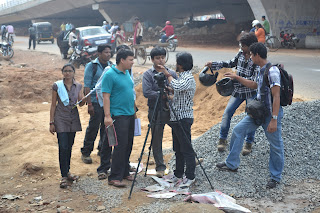Hi frnz, 2day was a very awesome, wonderful, beautiful n an exciting day 4 me as it was my BIRTHDAY 2day. I had a get together with my FAMILY n my SWEETHEART FRIENDZ. It will b a memorable day 4 me 4 a lifetime
Saturday, 28 April 2012
Wednesday, 28 March 2012
SOUND
Sound is an invisible vibration. It travels in waves, spreading outwards from the source of the sound.
Sounds are different both in loudness and pitch, often known as Frequency.
Loudness is measured in decibels (db).
Pitch / Frequency is measured in Hertz (Hz).
* All sounds are made up of different frequencies. We can describe this as the pitch of a sound. The frequency of a sound affects the pitch that it is heard at. The sound of a whistle makes when its blown is an example of a high frequency pitch whereas the noise made when banging on a drum is an example of a low frequency pitch.
* Speech consists of mixed frequencies. Consonants are generally higher in frequency that vowels. Some children's deafness occurs at different levels, depending on the frequency.
* LEVELS OF DEAFNESS
The four categories below are to indicate the level of an individual's hearing loss :-
- Mild deafness :- 20-40db
- Moderate deafness :- 41-70db
- Severe deafness :- 71-95db
- Profound deafness :- 95+db
WHAT IS SOUND????
Sound is a physical vibration that moves our eardrum and nerves attached to our eardrums and that send information to our brain. Sounds are of two types:-
* Analogue Sound
* Digital Sound
* Analogue Sound- If we are recording with a microphone, as we hold the microphone up in the air and the microphone converts the changes in the air pressure into change an electrical voltage. This is called as Analogue Sound.
* Digital Sound- It is a technical process where by an analogue audio is first converted in a continues stream of numbers. The digital audio consists of bits of data 1 & 0. Analogue sound first needs to digitalized or converted to digital data before it can worked on the computer.
UNIT OF SOUND
Decible (db) is used to measure the intensity of the sound.
FILE SUPPORT
Sound Forge supports opening and saving various audio formats like mp3, WAV, WMA, etc.
Sound Forge supports opening and saving of Microsoft Audio and Video Interleave (AVI), Windows Media Video (WMV), Quick Time (MOV) and Motion Picture Export Group (MPEG) video files.
* MIX- Mixing allows multiple sound files to be blended into one file at user defined relative level.
* OVERWRITE- This command is used to replace the selected sound data with the contents of the clipboard.
* REPLICATE- This command is used to paste as many copies of the clipboard to be fit in the current section.
* NORMALIZE- The normalizing process will calibrate our recording to a standard volume to ensure that some portion are not significantly louder than other portion.
FILE FORMAT
A file format specifies the way in which the data is stored. In windows, the most common audio file format is the Microsoft Wav Format.
Sounds are different both in loudness and pitch, often known as Frequency.
Loudness is measured in decibels (db).
Pitch / Frequency is measured in Hertz (Hz).
* All sounds are made up of different frequencies. We can describe this as the pitch of a sound. The frequency of a sound affects the pitch that it is heard at. The sound of a whistle makes when its blown is an example of a high frequency pitch whereas the noise made when banging on a drum is an example of a low frequency pitch.
* Speech consists of mixed frequencies. Consonants are generally higher in frequency that vowels. Some children's deafness occurs at different levels, depending on the frequency.
* LEVELS OF DEAFNESS
The four categories below are to indicate the level of an individual's hearing loss :-
- Mild deafness :- 20-40db
- Moderate deafness :- 41-70db
- Severe deafness :- 71-95db
- Profound deafness :- 95+db
WHAT IS SOUND????
Sound is a physical vibration that moves our eardrum and nerves attached to our eardrums and that send information to our brain. Sounds are of two types:-
* Analogue Sound
* Digital Sound
* Analogue Sound- If we are recording with a microphone, as we hold the microphone up in the air and the microphone converts the changes in the air pressure into change an electrical voltage. This is called as Analogue Sound.
* Digital Sound- It is a technical process where by an analogue audio is first converted in a continues stream of numbers. The digital audio consists of bits of data 1 & 0. Analogue sound first needs to digitalized or converted to digital data before it can worked on the computer.
UNIT OF SOUND
Decible (db) is used to measure the intensity of the sound.
FILE SUPPORT
Sound Forge supports opening and saving various audio formats like mp3, WAV, WMA, etc.
Sound Forge supports opening and saving of Microsoft Audio and Video Interleave (AVI), Windows Media Video (WMV), Quick Time (MOV) and Motion Picture Export Group (MPEG) video files.
* MIX- Mixing allows multiple sound files to be blended into one file at user defined relative level.
* OVERWRITE- This command is used to replace the selected sound data with the contents of the clipboard.
* REPLICATE- This command is used to paste as many copies of the clipboard to be fit in the current section.
* NORMALIZE- The normalizing process will calibrate our recording to a standard volume to ensure that some portion are not significantly louder than other portion.
FILE FORMAT
A file format specifies the way in which the data is stored. In windows, the most common audio file format is the Microsoft Wav Format.
Subscribe to:
Comments (Atom)


























